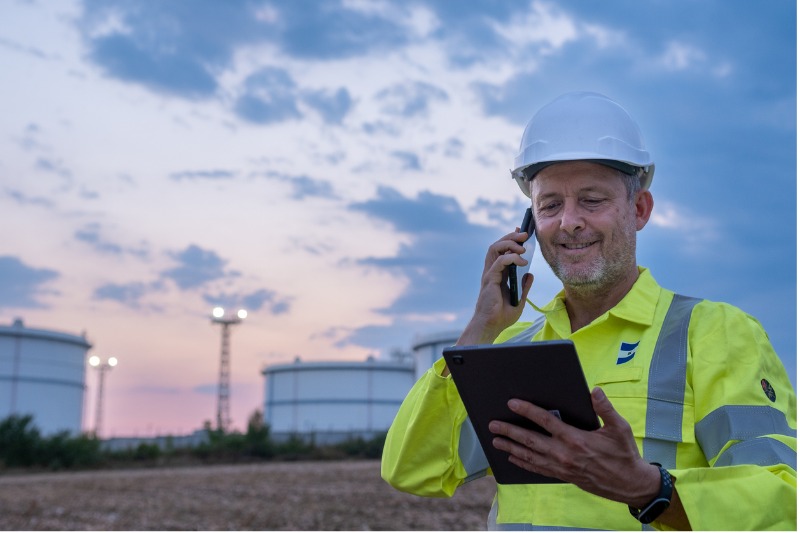
On-site safety is the number one priority whether it’s a mine, oil and gas site, or out in the field. Rugged devices have come a long way to provide workers with reliable, highly effective smartphones, tablets, and laptops.
Advancements in mining & safety technology
Mining and safety technology has developed over the past decades to improve productivity and safety on site. Workers carry rugged smartphones, tablets, and laptops that have evolved to be essential trade tools. Staff members on oil and gas sites can now take an intrinsically safe device knowing it has all the capabilities of a regular rugged device without risks.
Advancements in field & public services technology
The mining industry often leads the way in demanding technology improvements for safety purposes that other field and site industries can benefit from. Emergency services such as police now have access to records that were previously only available in the office. Now the information is accessible at the push of a button where they need it, out on the road. Public utilities, warehousing, transport, and logistics are better connected to colleagues, data, and emergency services, making their jobs safer and more productive.
Safety Feature Advances in Rugged Devices
Site staff have access to rugged devices that can provide the technology they need to do their job faster and safer.
#1 Push-to-Talk
Workers are often on their own in remote locations. They rely heavily on their rugged smartphone or ipad should the worst happen. The push-to-talk function means a worker can connect to their team on 100 channels. They can choose from one-to-many group communication, one-to-one communication within a group channel, or one-to-one communication with a colleague. The push-to-talk function turns the smartphone into a walkie-talkie and lone worker monitor. One rugged device can do the job of multiple devices. There’s no need to carry around more than one device; making sure they’re all charged and checked regularly, a rugged device can do it all.
#2 Communication Networks
With today’s rugged devices, there’s a lower chance that you’ll experience delays and downtime. For emergency services, officers need their devices to receive and relay information quickly, particularly in life-saving situations. Dead zones in mine sites are frustrating for workers, but most importantly, they are dangerous. On remote sites, where they can't benefit from metropolitan connectivity services, it’s crucial that devices can use what’s available. This includes Bluetooth, Wi-Fi, 3G, 4G LTE, 5G and integrated GPS. Workers need the peace of mind that they have access to fast connectivity, high-speed streaming, and few drop-outs in case of an emergency.
#3 Superior Screen Quality
Rugged devices need displays that can be viewed outside in the midday sun as easy as indoors. A 1500-nits screen makes for a safer work environment as the information will be clear and readable. A breakdown in communication in some locations is life-threatening.
Capacitive touchscreen technology means workers don’t need to remove their safety gloves to touch the display. Workers also have the choice of using their finger or stylus pen.
#4 Explosion Proof
Consumer devices aren’t allowed on certain worksites due to the risk of explosion. Hazardous areas are classified as Zone 0, Zone 1 or Zone 2 and intrinsically safe devices are rated to meet these zone classifications. Without the advancements in intrinsic technology, some sites couldn’t allow any devices because of the level of risk. Now there are devices to suit every location. Even iPhone and iPad consumer devices are being made safe with the development of XCIEL cases which safely encase the device without impeding its functionality.
#5 Protection of Sensitive information
Sites must protect their sensitive information from tampering, hacking, and theft. Rugged devices can use smart cards, RFID readers, face authentication, and fingerprint scanners. Checks for intrusion during system boot-up and disabling the device if unauthorised or uncompromised entry is detected, ensures data protection.
#6 Built Tough from Rugged Materials
Rugged devices are getting tougher. Unlike consumer devices, they can cope with dust, vibration, shocks, water, oil, and extreme temperatures. Despite their tough exteriors, the materials used in rugged smartphones, tablets and laptops don’t weigh down workers with heavy devices when carried around all shift. Keeping the weight of devices to a minimum means they aren’t a safety risk to transport in person or in a vehicle. Rugged accessories make it easier and safer for a rugged laptop, smartphone, or tablet to be carried around with you and in a vehicle.
#7 Long-life Batteries
Nothing is more frustrating than the battery on your device dying when working out in the field. Many rugged devices offer hot-swappable long-life batteries. This means workers don’t need to charge their devices as often as they previously did, and when the battery dies, it can be replaced with a fresh battery without the need to power down the unit. When you don’t have ready access to an electricity source, there’s peace of mind for workers knowing their device will keep them connected and safe in case of an emergency.
#8 Real-Time Data for Reduced Travel
Rugged devices are now providing on-site and head office staff with real-time data. In the past, some site staff had to travel long distances to relay the information to head office or a supervisor so decisions could be made. Now the rugged laptop or tablet removes the need for risky, non-productive travel to a physical office. The high-performing devices can do everything right there on site.
If you are not sure which rugged device is best suited for your site, call 1300 131 933 or get in touch with us online. Our team will consider your requirements before recommending suitable devices.